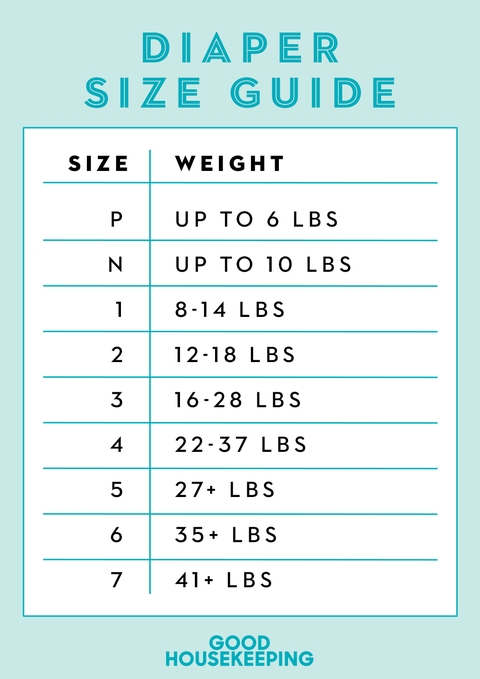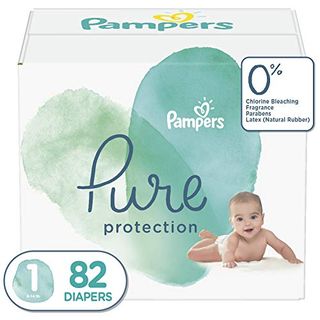Worsted Weight Yarn Needle Size for Socks
Becoming a new parent can be confusing enough; the last thing you should worry about is deciphering a diaper size chart to figure out which ones to stock up on. Babies go through thousands of diaper changes before potty training, so there's no doubt you'll be a diaper expert by the time you're through.
Until then, the parenting experts at the Good Housekeeping Institute break it down for you here. Our fiber scientists evaluate diapers in the Textiles Lab using a variety of absorbency tests, including how quickly each one can absorb fluid, how much liquid leaks off when the diaper's held at an angle, and how dry the surface stays when a weight is applied. We also send them home with parent testers to get in-depth, real-life feedback.
How do diaper sizes work?
First things first: D iapers are sized by weight and not by age. Most babies will start in the Newborn size (which also has a cut-out in the front for the umbilical cord) then ultimately spend the majority of their diapering days in size 4, the most popular size on the market. Beyond that, there's no way to accurately predict ahead of time what size diapers your baby will be in at each age because babies grow at different rates. Still, it's safe to say babies will at least cycle through sizes 1, 2, and 3 during the first year.
Most disposable diaper brands are available in sizes Newborn through 6. On either end of the spectrum, Huggies and Pampers both offer a Preemie size for babies under six pounds, while Pampers even offers size 7 for toddlers over 41 pounds. Here is your ultimate diaper size chart based on the most popular, best performing diapers on the market:

Babies grow so quickly during the first year so they'll spend less overall time in the smaller-sized diapers, yet you'll use up more diapers when they're younger. Newborn babies can go through 12 diapers a day (that's 360 diapers in the first month!), but that drops down to 5-8 diapers per day by the end of the first year. Keep in mind: The smaller the diaper size, the more diapers you get in each box. Diaper packages may cost the same when you buy them, but you're paying slightly more per diaper as you size up.
When to switch to the next diaper size
You'll notice there's some overlap in weights between sizes. If your baby is in between and you truly can't decide, we recommend sizing down because the cost per diaper is less and a too-loose diaper can cause leaks. Still, your best bet is to pay close attention to when your baby is outgrowing their current size. Here's what to look out for:
- Stretch at the waist: The tabs to secure the diapers should fit snug without you having to pull them shut.
- Coverage around the legs: Your baby's bottom should be fully enclosed by the diaper to prevent leaks and blowouts. The leg cuffs shouldn't be tucked in.
- Red marks on skin : If you see impressions when you change the diaper, it could be a sign that the fit is too tight.
Parents sometimes complain that Newborn diapers seem too small, yet Size 1 seems too big. If this is the case for you, try using Size 1 and folding down the waist before you put it on. You can also consider trying another brand; every baby is shaped differently and some brands may fit your little one better than others.
Your Disposable Diaper Size Guide by Brand
If you're looking for information on a specific diapers, here are the best performing and most popular options on the market, with the size charts exactly how they're shown on the brand's website:
Pampers Size Guide
Pampers is a Good Housekeeping Seal holder and has the most diaper sizes to choose from, with Preemie available in Pampers Swaddlers and Size 7 available in Pampers Cruisers. Though they're not as widely available, you can also get extended Preemie sizes P-2 for under 4 lbs and P-3 for under 1.8 lbs.
The brand also has the most diaper style options on the market, including Pampers Pure for a bigger focus on plant-based materials and Pampers Cruisers 360 Fit for active babies. Just note that size offerings will vary by style; for instance, Cruisers and 360 Fit start at Size 3 because they're designed for crawlers and walkers.
- Premie: <6 lbs
- Newborn: <10 lbs
- Size 1: 8-14 lbs
- Size 2: 12-18 lbs
- Size 3: 16-28 lbs
- Size 4: 22-37 lbs
- Size 5: >27 lbs
- Size 6: >35 lbs
- Size 7: >41 lbs

Swaddlers Diapers
Pampers amazon.com
$47.07

Cruisers Diapers
Pampers amazon.com
$50.99

Pure Protection Diapers
Pampers amazon.com
$49.99

Swaddlers Overnights Diapers
Huggies Size Guide
This is another popular choice (and one of our top-tested diaper brands) with lots of options to choose from. Diapers sizes range from Preemie to 6, but like Pampers they'll vary by style. Little Snugglers is the only diaper in Preemie and Newborn sizes, while Little Movers (for crawlers and walkers) start at Size 3.
- Premie: <6 lbs
- Newborn: <10 lbs
- Size 1: 8-14 lbs
- Size 2: 12-18 lbs
- Size 3: 16-28 lbs
- Size 4: 22-37 lbs
- Size 5: >27 lbs
- Size 6: >35 lbs

Little Snugglers Diapers
Huggies amazon.com
$50.44

Little Movers Diapers
Huggies amazon.com
$65.86

Snug & Dry Diapers
Huggies amazon.com
$52.62

Overnites Diapers
Huggies amazon.com
$79.64
Luvs Size Guide

Luvs
Triple Leakguards Diapers
Luvs is Pampers' more affordable sister brand. Unlike Pampers and Huggies, there's just one diaper style so you don't have to make the choice, and it's available in sizes Newborn through 6.
- Newborn: Up to 10 lbs
- Size 1: 8-14 lbs
- Size 2: 12-18 lbs
- Size 3: 16-28 lbs
- Size 4: 22-37 lbs
- Size 5: 27 lbs+
- Size 6: 35 lbs+
The Honest Company Size Guide

The Honest Company
Honest Diapers
The Honest Company amazon.com
$25.99
These diapers are popular for their fun prints and eco claims, plus they performed well in our test. There's just one style for daytime in a wide range of designs, plus an overnight option.
- NB: Up to 10 lbs
- Size 1: 8-14 lbs
- Size 2: 12-18 lbs
- Size 3: 16-28 lbs
- Size 4: 22-37 lbs
- Size 5: 27+ lbs
- Size 6: 35+ lbs
Bambo Nature Size Guide

Bambo Nature
Eco Friendly Baby Diapers
Bambo Nature amazon.com
$13.50
The brand is pricey per diaper, but it's a great choice if you prefer greener options because it has transparent claims and performed better than other "eco" brands. They're European, so make sure to check the size chart because it's entirely different from the others in this roundup.
- Size 0: 2-7 lbs
- Size 1: 4-11 lbs
- Size 2: 7-13 lbs
- Size 3: 9-20 lbs
- Size 4: 15-40 lbs
- Size 5: 24-55 lbs
- Size 6: 33-66 lbs
Seventh Generation Size Guide

Seventh Generation
Free & Clear Diapers
Seventh Generation amazon.com
The company has a big focus on sustainability for a variety of consumer products. The diapers are available in day or overnight, though they didn't perform quite as well as others in our test. Also note that the size chart differs slightly from some of the other popular brands, so double check before you buy.
- Newborn: Up to 10 lbs
- Size 1: 8-14 lbs
- Size 2: 12-18 lbs
- Size 3: 16-21 lbs
- Size 4: 20-32 lbs
- Size 5: 27-35 lbs
- Size 6: Over 35 lbs
Hello Bello Size Guide

Hello Bello
Hello Bello Diapers
Hello Bello walmart.com
$7.97
This is a newer brand with tons of adorable prints, and it was one of the most absorbent diapers in our Lab's tests. They have two styles: A standard diaper and an overnight option. The size chart runs a little smaller than others, so this is another one where you'll want to review it carefully before you buy.
- Newborn: Up to 10 lbs
- Size 1: 8-12 lbs
- Size 2: 12-18 lbs
- Size 3: 10-16 lbs
- Size 4: 22-37 lbs
- Size 5: 27+ lbs
- Size 6: 35+ lbs
What about other types of diapers?
If you're confused on how to pick the size for a style of diapers that we haven't yet covered, here's the scoop:
- Overnight diapers are extra absorbent since you won't be changing them as frequently. They're sized the same way as daytime disposable ones, so you can follow the same size chart. We actually recommend going up one size for overnight styles so you get a larger absorbent core to soak up fluid. Just note that they typically begin at size 3 since most babies aren't sleeping through the night before then.
- Swim diapers are designed specifically for water use – unlike regular diapers, they won't swell up when they're wet. They have a pull-on, elastic fit and typically come in sizes Small, Medium, and Large, which are similar to diaper sizes 3, 4, and 5, respectively.
- Cloth diapers are reusable, machine washable alternatives to the disposable kind. They're usually one-size-fits-all for roughly 6 pounds to 35 pounds because they have built-in adjustable snaps.
- Training pants are technically diapers, but they have an elastic waist that can be easily pulled down during potty training. These are sized differently than regular diapers and are more aligned with age and clothing size. The typical sizes are 2T-3T, 3T-4T, and 4T-5T.
Lexie Sachs, Good Housekeeping Institute Textiles Director Lexie Sachs earned her Bachelor of Science degree in Fiber Science from Cornell University, and she researches, tests and reports on fabric-based products ranging from sheets, mattresses and towels to bras, fitness apparel and other clothing.
This content is created and maintained by a third party, and imported onto this page to help users provide their email addresses. You may be able to find more information about this and similar content at piano.io
Worsted Weight Yarn Needle Size for Socks
Source: https://www.goodhousekeeping.com/life/parenting/a32960612/diaper-sizes-guide/
0 Response to "Worsted Weight Yarn Needle Size for Socks"
Post a Comment